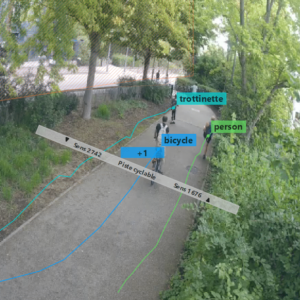Passenger Countring in Transportation: technologies, advantages, disadvantages
As a research manager, operations manager, or part of the Marketing Department of a public transport network, you are certainly faced with a recurring challenge: that of understanding and optimizing the management of your network To achieve this, having access to precise, reliable, and comprehensive data can really make a difference.
Quantifying ridership based on data allows for in-depth analyses and actions based on what is observed and the demand expressed by the users
This article, focusing on passenger counting in transportation (trains, metro, buses, trams, etc.), has been specially written to help you adopt the most effective operational approach
Why Measure Ridership in Transportation?
Measuring ridership in public transportation is a cornerstone in addressing many critical issues in this sector
For effective management of the transportation network.
One of the major challenges faced by transportation network managers is to ensure effective management of capacity and punctuality. Without a precise understanding of passenger demand at different times and on different lines, it is difficult to appropriately size services. Passenger counting can also provide a real-time view of the crowd, allowing operators to take proactive measures to avoid overcrowding or delays.
To Improve Customer Experience
Passenger satisfaction is central to the success of transportation. Delays, insecurity, or infrequent service can significantly undermine the success of public transport policies, for example.
By accurately measuring ridership, operators can anticipate demand peaks and adjust services accordingly. Continuous/real-time information can also be used to inform passengers about delays and available alternatives (shuttles, suggested routes, etc.), thereby enhancing their overall experience.
For Strategic Transportation Planning
To evolve and meet the changing needs of travelers, public and private transportation networks must be constantly evolving. Measuring ridership provides historical and/or real-time data that are essential for strategically planning new routes, optimizing schedules, and potentially developing additional services. It also allows for assessing the effectiveness of initiatives and long-term investments, for example, to evaluate the impact of new policies.
To Reduce Environmental and Economic Impact.
Public transportation plays a crucial role in reducing road congestion and greenhouse gas emissions. More efficient use of services through ridership measurement can help reduce reliance on individual cars and promote more sustainable mobility. Moreover, optimal network management can lead to significant cost savings for both operators and users. The key arguments for shifting from car use to public transport will be: the coverage, frequency, and punctuality of the network..
The Importance of Continuous Passenger Counting
Continuous measurement of ridership in public transport is an essential tool for effectively addressing urban mobility challenges and improving the quality of services offered to users.
Dynamic Optimization of Services
Monitoring passenger flows allows for dynamic and responsive management of the network. By analyzing real-time ridership data, operators can quickly adjust the frequency and capacity of services to respond to demand fluctuations. This not only prevents overcrowding and underuse of resources, but also ensures that services are both economical and environmentally friendly.
Responsiveness to Unforeseen Situations
Unforeseen incidents, such as inclement weather, strikes, technical failures, or items considered as ‘abandoned‘, can significantly disrupt transportation networks. Continuous ridership measurement gives operators the ability to quickly respond to these events, adapting services to minimize inconvenience for passengers. This may include deploying additional services, adjusting routes, or providing real-time information to passengers to help them plan their journeys.
Improvement of Service Quality, User Experience, and Passenger Safety.
Finally, continuous ridership measurement directly improves the user experience. Passengers benefit from more reliable services, with less waiting time and congestion. Real-time information on crowd levels can be communicated to passengers via mobile apps or information screens, allowing them to make more informed decisions about their route.
Regarding safety, monitoring the movements and densities of passengers in different segments of the network allows operators to quickly identify high-risk areas where panic situations or accidents are more likely to occur. This surveillance can detect abnormal behaviors or potentially dangerous situations, such as unexpected crowd movements, allowing for a swift response to ensure the safety of users. All of this, along with statistical information on passenger volumes.
All of this, along with statistical information on passenger volumes.
Continuous ridership measurement, through the historical recording of measured data, enables various ‘post-event’ analyses such as:
- Measuring the year-over-year traffic evolution
- Measuring the variability of flows between different days of the week (weekday compared to Wednesday, a weekday compared to the weekend), school periods vs. holiday periods (short holidays, summer vacations)
- Evaluating the impact of different types of incidents, for example, the impact of an abandoned package. Having a long series of data will provide data on several cases of ‘abandoned packages,’ making it possible to compare these cases with each other and to compare these cases to a ‘standard’ day.
- Assessing the impact of exceptional events, such as sports or cultural events, local festivities, etc.
These measurements, therefore, enhance confidence in the public transportation network and can encourage more users to choose these more sustainable modes of transportation.
Traditional Counting Methods
It is customary in the history of public transportation (before the era of modern technology) for network managers to conduct counts and measure ridership using methods referred to as ‘traditional’ (which are still called so)
Manual Counts and Surveys
Manual passenger counts and surveys, including Origin-Destination surveys, were among the earliest methods for measuring passenger ridership. These methods typically involve surveyors manually counting passengers at specific points, such as stations or stops. Origin-Destination surveys go further by recording, through interviews, the origins and destinations of passengers, their travel habits, and frequency, providing qualitative data as well.
Advantages :
- Allows for obtaining qualitative data and specific insights.
- Flexibility in the choice of measurement points and criteria.
- Possibility of obtaining demographic information and feedback from passengers’ experiences.
Limitations:
- Labor-intensive and potentially costly, especially for data collection beyond the scope of a single day.
- Risk of errors or biases in data collection, especially in cases of high ridership.
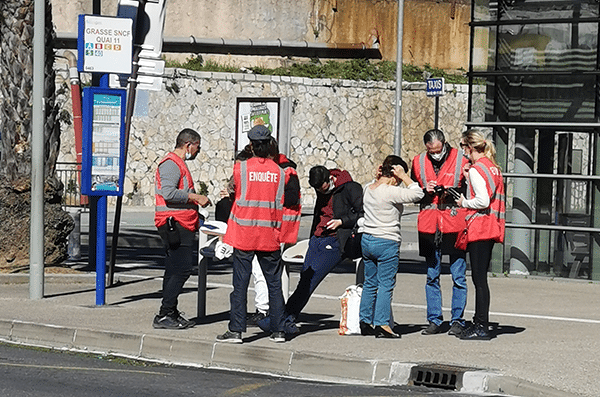

Mechanical Counters
Mechanical counters, such as turnstiles or gates, have been and are still used to count passengers at the entrance or exit of metro stations, train stations, or terminals. These devices count each person who physically passes through them.
Advantages:
- Accurate and automated counting.
- Suitable for high-traffic environments.
Limitations:
- Limited to specific points in the network.
- Do not provide information about movements inside vehicles or stations, nor more specific information about the type of user or their travel motives.
Tickets and Subscription Cards
The use of tickets and subscription cards also allows for the collection of ridership data. Every time a passenger purchases a ticket or validates a card, an entry is recorded. Modern ticketing systems can be coupled with geolocation data to provide a more precise understanding of travel patterns.
Advantages:
- Continuous and automatic data collection.
Limitations:
- Does not measure ridership in real-time.
- Depends on the reliability of passengers to correctly purchase or validate their tickets.
Traditional methods of passenger counting have played an essential role in the history of public transportation. They have allowed for the collection of valuable data for planning, pricing, and service optimization. However, they have significant limitations, including costs, accuracy, the ability to provide real-time and/or behavioral data.
Automated Passenger Counting Technologies
The rapid evolution of technology has introduced new methods of passenger counting in public transportation, offering significant advantages over traditional methods. This section will explore the passenger counting technologies available on the market today, their use cases, and the advantages and disadvantages of each technology depending on what one wants to measure.
This is a comparison of technologies that, while effective, requires technical skills and expertise in people flow analysis to position sensors optimally, determine relevant key performance indicators (KPIs), and conduct field deployment, which is not trivial in the public transportation domain..
Automatic Passenger Counters (Infrared or Stereoscopic Technology)
Counting cells use technologies like infrared or stereoscopic to automatically detect and count passengers as they board vehicles or pass through access gates. These devices offer high accuracy and allow for real-time data collection.
Advantages:
- Continuous and automatic real-time data collection.
- Precise counting.
- Minimization of human error.
Limitations:
- Suited for narrow passages (single-file)
- Dependent on the quality of the communication network (3G/4G/5G). Can be problematic for counting in underground areas.
Fare Collection Systems (RFID and NFC)
Fare collection systems based on RFID (Radio-Frequency Identification) and NFC (Near Field Communication) technology allow passengers to pay for their journey using subscription cards or smartphones equipped with RFID or NFC chips These systems automatically record each validation, providing accurate and real-time ridership data.
Advantages:
- User Journey Tracking
- Passive data collection, with each ticket validation.
Limitations:
- Does not account for users without tickets or with unvalidated tickets, which can be problematic during free pass events, for example.
- May lack precision in measuring flows within the network.
Smart Sensors: 2D Cameras with AI
Cameras equipped with artificial intelligence (AI) can automatically detect and count passengers in various environments (on platforms, at station entrances, etc.).
From the image stream, data processing algorithms apply to the images in real-time to transform a simple video stream into instant statistical and anonymous data.
These systems can distinguish entries and exits and provide information about user behavior (waiting time on the platform, entry into restricted areas, detection and counting of users with strollers, suitcases, bicycles, etc.), all without human intervention.
Automated passenger counting by AI is particularly useful for counting, security, and operational assistance purposes. Currently, it is the most efficient and versatile device for all types of situations (can count with a zenithal or angled view).
Advantages:
- Instant Monitoring and Counting
- User Behavioral Analysis
- Measurement in open indoor and outdoor spaces, as well as in wide or narrow passages, on platforms, or at entrances.
Limitations:
- Technology providers must demonstrate compliance with data protection regulations (GDPR) in their processing.
- The installation of cameras requires on-field expertise to ensure that the quality of the results produced is not compromised.
Example of Passenger Counting by Smart Cameras
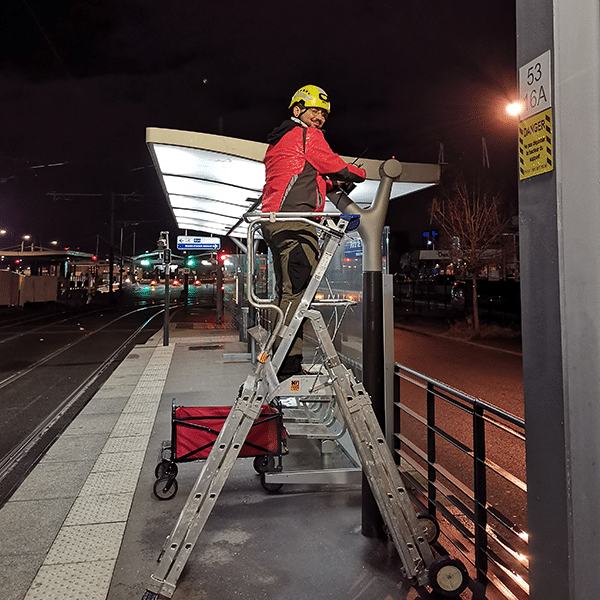
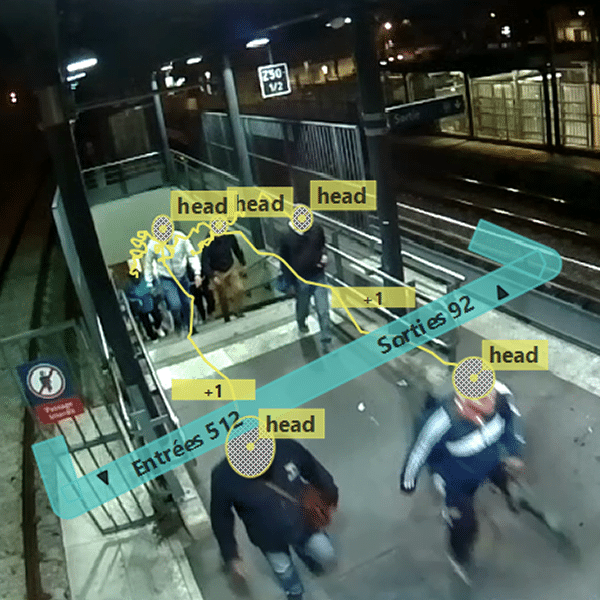
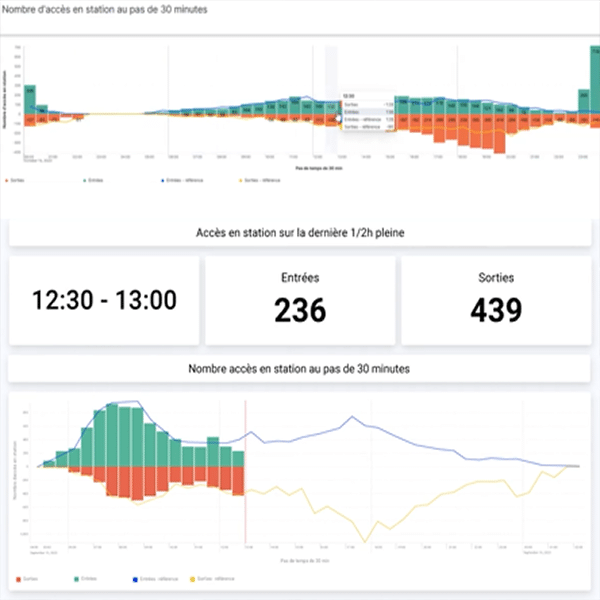
Smart Sensors: Stereoscopic 3D Cameras
3D cameras use stereoscopic vision technology to capture three-dimensional images. They can measure the distance between the camera and objects, allowing for precise counting. The 3D cameras are to be placed in a zenithal position at the location where counting is desired.
Advantages:
- Real-time Automated Counting
- Can measure high foot traffic in narrow or wide passages.
Limitations:
- Requires Power over Ethernet (PoE) wiring, which may not be suitable for all configurations.
- Does not distinguish specific classes such as shopping carts, strollers, or others.
Wi-Fi and Bluetooth Traces from Smartphones
Almost all smartphones are now equipped with features like Wi-Fi and Bluetooth. These features can be used to track passenger presence in transportation. When passengers enter a vehicle or pass by one of these tracking systems, the sensor will detect when a smartphone has its Wi-Fi or Bluetooth enabled and use the smartphone’s IP address to count users.
Advantages:
- It allows reconstructing a passenger’s journey by tracking smartphone movements inside the network and collecting data on the duration and route of the journey.
Limitations:
- It must ensure data anonymization to respect privacy.
- It requires having an adequate technological infrastructure.
- This is not an exhaustive analysis (in a first approach, a sampling rate of 25% to 40%).
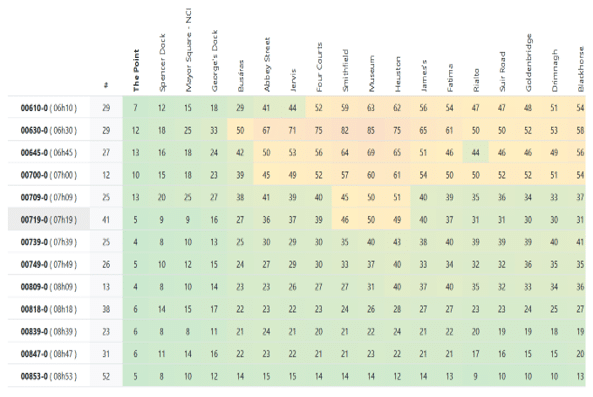
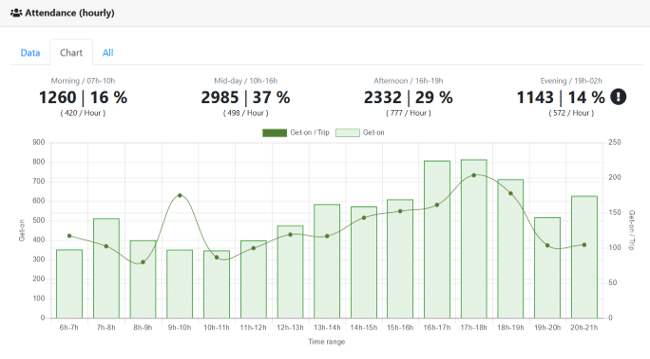
GPS data and mobile applications
Public transport mobile apps often use GPS data from smartphones to track the location of passengers. This allows operators to collect data on travel, arrival times at stops, and provide passengers with real-time information. This technology is also useful for collecting user feedback.
Advantages:
- Real-time data collection and interaction with users
- Personalization of the customer journey.
Limitations:
- Bias towards users of the application (does not capture the entire public).
- User data protection management.
Conclusion and Perspectives
Measuring passenger flow in public transport is more than just data collection; it is a key to solving the major challenges faced by transport network managers, whether it’s modal shift issues, service evolution, or passenger service optimization.
Traditional passenger counting methods have been the starting point for this crowd measurement approach and are still in use today. However, some of them have limitations in terms of costs, accuracy, and the ability to provide real-time data. The era of advanced passenger counting technologies offers significant advantages in terms of accuracy, real-time data collection, and detailed analysis.
However, our exploration does not stop there. The same advanced technologies that are revolutionizing data collection in public transport can also be applied to predicting crowds during massive events such as major sports (Olympics, international matches, etc.) or cultural events (concerts, etc.).

- Publié le
We recommend best practices in advance of passenger counting projects.
Let's plan a discussion about your passenger counting challenges on your network: contact us!


